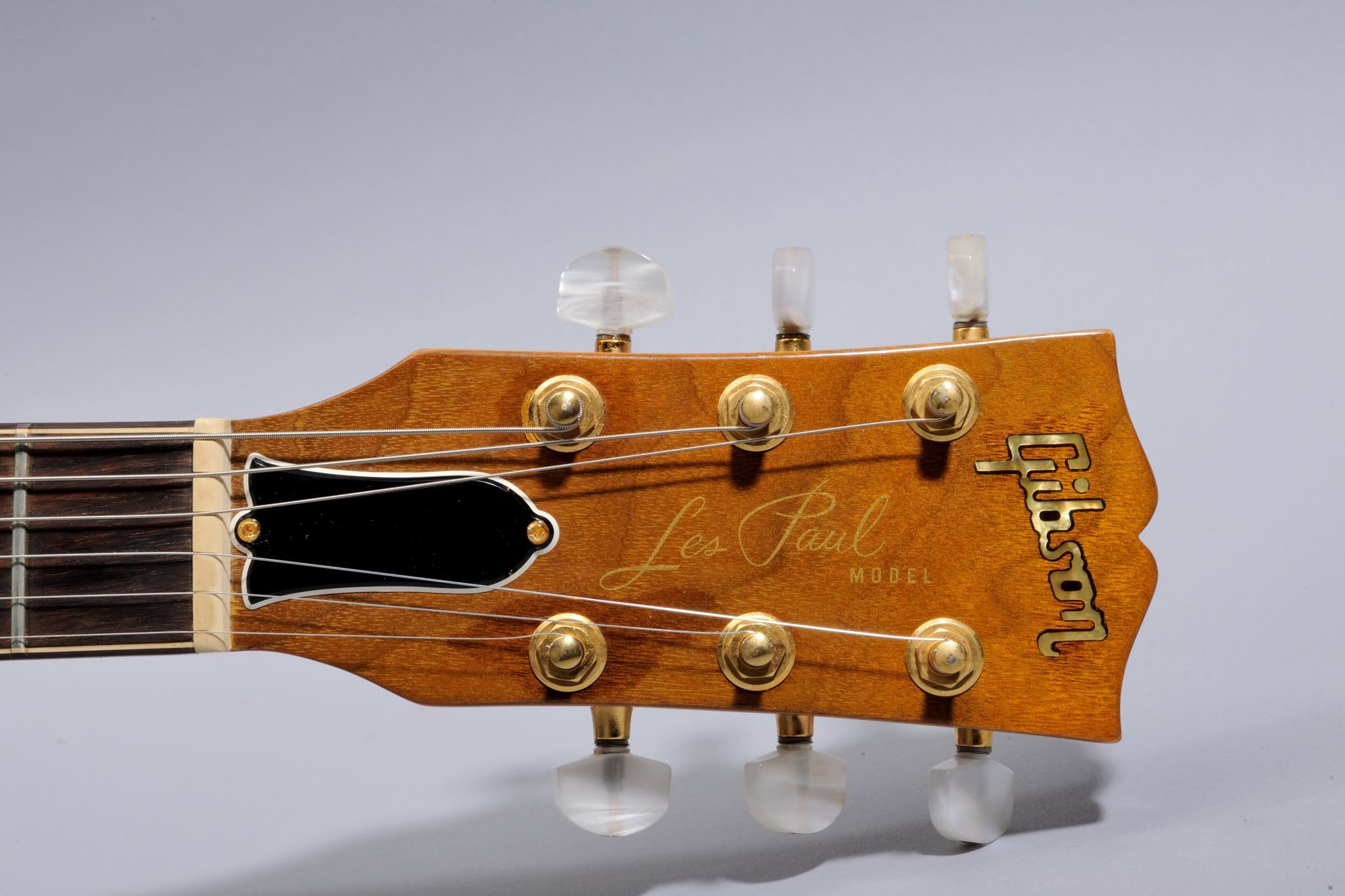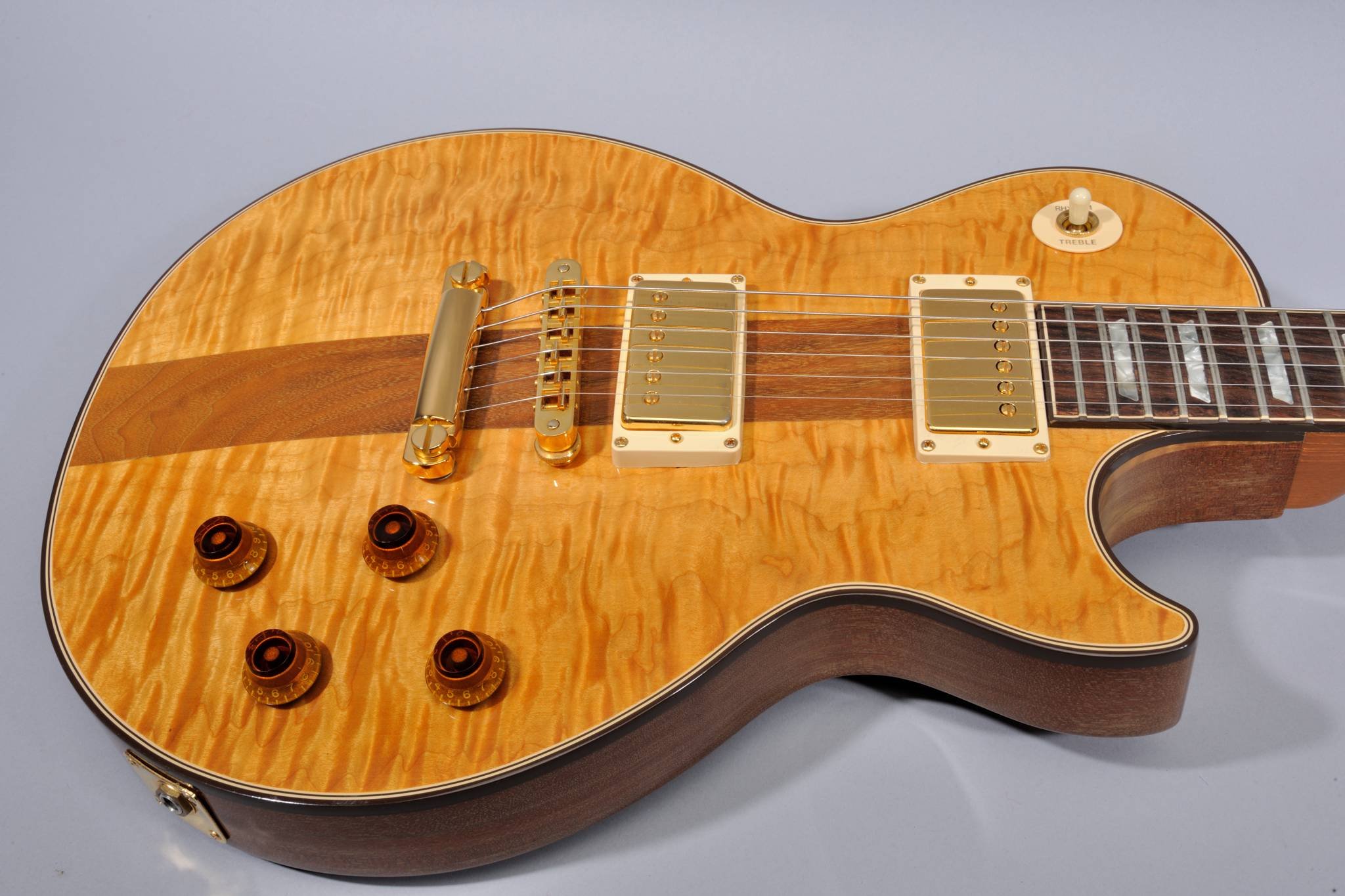Gibson 1983 Les Paul Spotlight Special Antique Natural #54 of 211
Gibson 1983 Les Paul Spotlight Special Antique Natural #54 of 211
Gibson 1983. Les Paul Spotlight Special in Antique Natural Finish.
#54 of 211.
Custom Shop Edition.
Flame Top.
#83 054.
The Les Paul Spotlight Special mystery solved by Michael A. Slubowski
It was 1983, and Gibson was in the throes of its darkest days. Norlin Industries, Gibson's parent company at the time, had incurred excessive debt, sales had fallen 30 percent the year before, and the Gibson name was for sale. By that summer, all of the large runs of Gibson models, including the Les Paul, had been moved to the Nashville factory, and the plant manager in Kalamazoo was informed the plant would close. Amidst the chaos and uncertainty, an idea was borne for a limited run of Les Pauls dubbed the Spotlight Special. Consumer interest in the model was certainly never rampant, but the 1993 release of the Tony Bacon/Paul Day book, The Gibson Les Paul Book, raised eyebrows and the interest of a handful of collectors. Those who set out to buy (or collect) Spotlight Specials soon discovered just how limited their production was, and searching for facts regarding the model often led to erroneous specifications and misinformation. Granted, the history surrounding the Spotlight is sketchy. Bacon and Paul Day report that Nashville managers concocted the Spotlight Special after spotting leftover walnut and pieces of curly maple. Some collectors believed their Spotlights were produced at Kalamazoo, and refuted the notion that the Spotlight was an assemblage of leftover parts, preferring to believe it was a carefully planned model. Jeff Cease, a former Gibson employee who helped research this article, spoke to an employee who worked at the Nashville plant at the time. The source confirmed that Spotlights were indeed built in the Nashville plant (Gibson USA) and, despite their Custom Shop Edition decal, were not affiliated with the Custom Shop (Gibson's Custom, Art, & Historic division), but were built on the regular production line. The source also said there weren't many made, and they were most likely built of surplus parts. Walter Carter, former historian for Gibson, notes that Gibson's records indicate Spotlight Special serial numbers up to 211, so it was indeed a limited edition.
The Spotlight Special is instantly recognizable by the contrasting strip of walnut down the center of the body, with curly maple or quilted maple on both sides of the strip. It has a gold Custom Shop logo on the rear of the headstock, with an inked serial number of 83-XXX, with "XXX" ranging from 001 to 211.
Again, published information is conflicting and inaccurate. The Bacon/Day book describes the headstock veneer as rosewood, when in fact it is mahogany on one model, ebony on the other. In its reference listing, the Bacon/Day book describes only one generic model, there are actually two. The fifth edition of the Blue Book of Electric Guitars incorrectly describes the center strip as mahogany and says it has a raised cream pickguard (Gibson specs do not call for a pickguard and although some Spotlights have them, many don't), chrome hardware (all Spotlights had gold-plated hardware), natural finish (they were available in natural and a darker finish), and manufactured from 1980 to '85 (the only serial numbers for this guitar are from '83). The only accurate description of the Spotlight is in Gruhn's Guide to Vintage Guitars, Second Edition, by Gruhn and Carter.
The only available written record of the Spotlight is a 1983 spec sheet from the Gibson archives, provided by Cease. It indicates there were two distinct models of Spotlight Special - the ASB and the ANT. Both have the Custom Shop logo on the rear of the headstock, the 83-XXX serial number, solid mahogany body and the 2" walnut strip down the center of the maple top, gold-plated hardware, including an adjustable Tune-O-Matic bridge, and stop bar tailpiece, two original PAF humbucking pickups, a one-piece solid mahogany neck with SP-1 peghead with 17-degree pitch, a black truss rod cover with no writing, a bound rosewood fingerboard with deluxe inlays and corresponding side dots. And both had a suggested retail price of $1,299, including Protector II case.
From there, however, the similarity ends.
The ASB model (antique sunburst) came with a "...highly figured quilted maple top," solid cream-colored binding, traditional ebony head veneer with Gibson pearl inlay, and traditional keystone-shaped machine heads (probably all with double-ringed tuners). There is tremendous variation in the colors (dark tobacco to lighter brown, and at least one in three-color sunburst) and grade/quality of the quilted tops. It also appears some workers were meticulous about bookmatching the tops, while others picked up whatever was available - maybe they thought nobody would notice the sides didn't match because they were separated by a 2" walnut strip?
The ANT model (antique natural) came with a "...highly-figured curly maple top," brown binding with two cream pinstripes on the body and one cream pinstripe on the neck, a walnut head veneer in light stain with Gibson logo inlay, and individual pearloid kidney-shaped machine heads. ANT models are definitely the more exotic-looking of the two because of the color, contrasting dark binding, and less-common tuner buttons. Among the ANT models on the market there is less variation in color (all are antique natural, some more gracefully aged), but again, the grade/quality of the curly maple tops and the attention to bookmatching is highly variable.
Gibson started making reissue-style Les Pauls in '83, and the Spotlight Specials exhibit some features of the reissue. The strip of binding on the cutaway is styled after the '50s models (consistent width, follows the contour of the body, exposing some of the maple top below the binding, compared to the deeper strip of binding with a straight edge following the maple/mahogany join on other models). Most Spotlights are in the nine-pound range, versus other notoriously heavy Les Pauls of the late '70s/early '80s. And Spotlights do not have the dreaded volute on the back of the neck. They are basic Les Pauls in terms of electronics and hardware; there are no coil taps or TP-6 tailpieces. With the exception of their looks (and the tuners on the ANT), Spotlights have the feel of a '59 Reissue, with excellent weight, tone and vibe. The neck thickness is somewhere between a '59 and '60. Despite the belief of poor production quality in the '70s and '80s, most Spotlights are of excellent quality, including fit and finish. A metal cover shields the pots beneath the back access plate.
Please have a look at this very interesting video from The Trogly's Guitar Show about these guitars
Gibson Les Paul Spotlight Special Collection!
https://www.youtube.com/watch?v=dSJDJQSNfRg
Gibson Spotlight Antique Natural ANT









